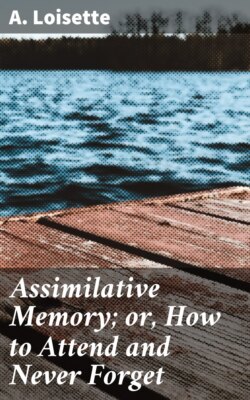Читать книгу Assimilative Memory; or, How to Attend and Never Forget - A. Loisette - Страница 13
На сайте Литреса книга снята с продажи.
REMARKS ON THE THREE LAWS.
ОглавлениеTable of Contents
1. Since words have different meanings, we may sometimes find that a pair of words exemplify all three Laws, as plough and sword. The relation between them may be In., since both of them are cutting instruments; one cuts and hacks human beings and the other cuts and turns over the soil. It may be Ex., in a metaphorical sense, as one is the emblem of peace and the other of war, and it may be Con., as we have often thought of them together as we read in the Bible of beating swords into ploughshares.
2. Learning a series of words by heart by thinking of the Relations between them is wholly unlike learning it by rote. In the latter case, three or five words at a time or all ten words are read over from 10 to 20 times. This reading secures scarcely anything more than a succession of sights to the eye or sounds to the ear. No study of the words is required. The action of the intellect is not invoked. It is the mere sensuous impression of Eye or Ear or both together that holds the words together, and thus many or endless repetitions are required to memorise a series which a conscious thoughtful use of those Laws enables us to learn by one painstaking perusal.
Another way of learning such a series by rote, is to limit the extent of the repetitions. Instead of reading over the entire series or a large part of it many times, the series is slowly read over once or several times by pairs, only two words at a time, but the method of acquirement is precisely the same as in the former rote process. Let us look at this last proceeding in detail. (1) It is usually applied only where there is a natural suggestiveness between each pair of words. (2) But no previous study is prescribed in regard to what constitutes this suggestiveness, nor are the varieties of it set forth and required to be mastered. (3) But above all, no study of the pairs of words themselves is insisted upon. On the contrary, all such study is emphatically deprecated. The mind is not allowed to be directed to anything in particular in reading over the pairs. It must be left without a rudder or guide to float wherever it listeth. It is not to be “interfered with” by our will. What is this but intellectual dawdling? A method of Vacuity pure and simple—the exact opposite of Mental Assimilation. (4) If in reading over many times an entire series, only the ear and eye are mainly affected and the intellect is left to wander, much more must it wander here. In running over many words, the intellect might be arrested by chance. But here the series consisting of two words only and all attempt to occupy or engage the intellect being purposely avoided, and nothing being done to enchain the attention to the consideration of the meaning or sounds of the two words, or the relation between them, the intellect wanders away from want of occupation. If when we wish to retain in our memories a paragraph of fine sentiment or lucid reasoning, we find our attention wanders, so it must wander here where only a pair of words is before it, and we are not only not furnished with any tests or guides or stimulus or motive for examining the words or for finding the relation between them, but on the contrary we are forbidden to interfere with the spontaneous action of the mind. The intellect might be abolished so far as its participation in such an operation is concerned. What is absorbed in such a case is absorbed intuitively and blindly. Hence we see that what is accomplished by these two processes of rote learning is weak impressions upon the memory and a distinct cultivation of mind wandering.
This method of rote learning by pairs was invented and first taught by Thomas Hallworth in New York in 1822. His method was adopted without acknowledgment by Carl Otto in Germany and Austria, and his followers in England and America. Footnote [A]
3. The opposite of these two methods of rote learning is my method, which injects an active process between each pair of words. Each pair of words is appraised and dovetailed by the Laws of Memory. And hence the reader can notice the fundamental difference between all other methods and mine. My method is to keep the mind in an assimilating, absorbing condition when trying to learn by making the Intellect stay with the Senses. In the process of endless repetition or learning by rote as evinced in the two methods above given, the mind is in a passive state. But when learning the above series by my method, it was kept in an active state. The intellect was directed by the will into certain channels and kept there. It was searching for what was in common or different between the pairs of words. It was noting points of likeness and classifying them. This is thinking. And the most vivid First Impressions always result from the action of the intellect upon the sensuous stimuli from ear and eye. Intellectual Assimilation is a proper name for my methods.
4. The Three Laws are Forms or Modes of Mental Assimilation. But when used consciously for any length of time, they operate much more efficaciously than formerly—and they greatly increase the Impressionability and Revivability—as any student can affirm who faithfully carries out my instructions, and then his General Memory becomes largely improved without a conscious use of my method.
